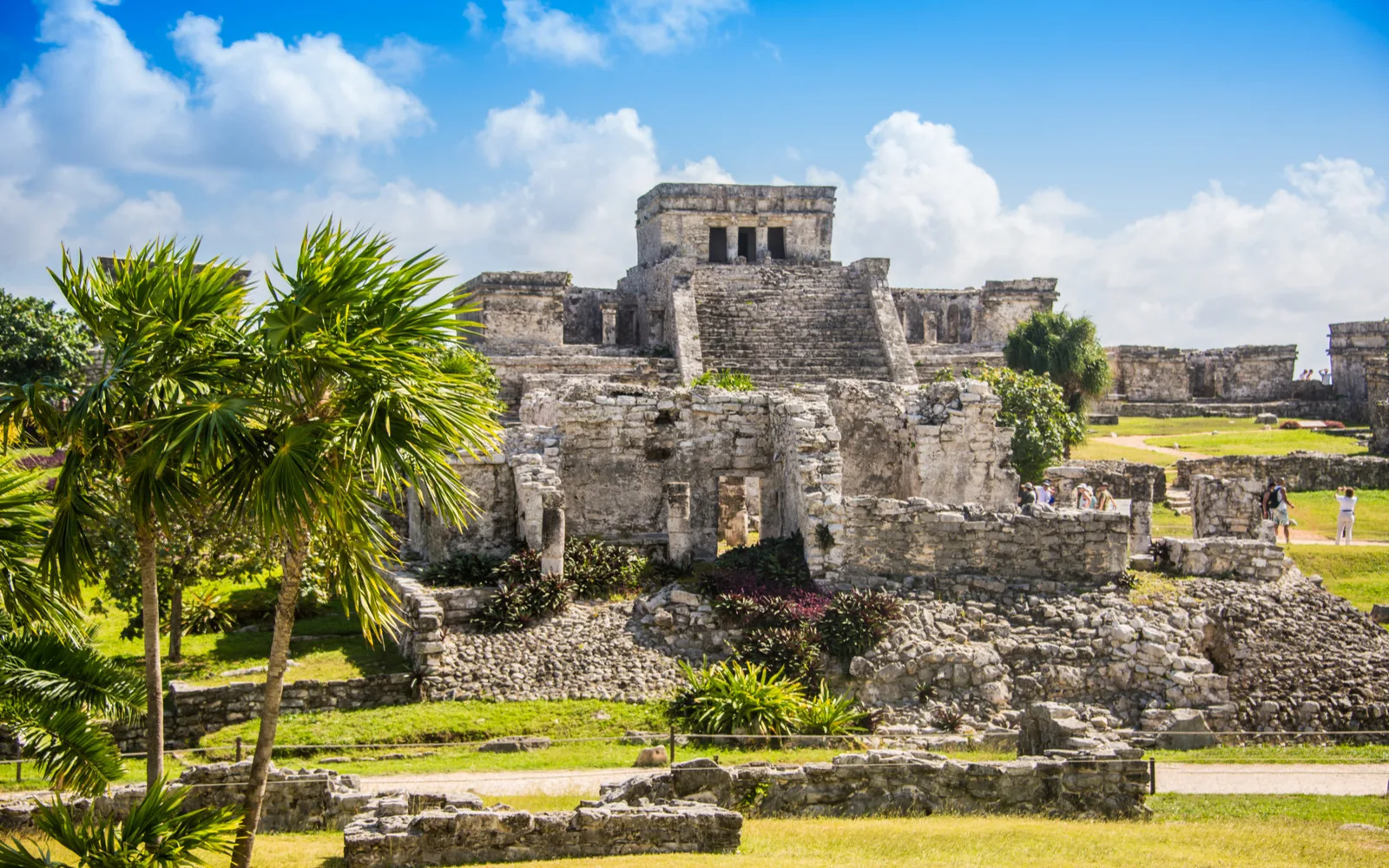Once spreading across 40 cities with roots dating back as early as 1500 BCE, the Maya people were one of the most advanced civilizations in Mesoamerica. Much of their society and culture remains a mystery today, but the best Mayan ruins in Mexico tell stories of their daily life, ceremonies, and religious beliefs. We’ll show you how to visit the best ones below.
7 Best Mayan Ruins in Mexico
If you’re journeying to Mexico, you owe yourself a visit to some of the best Mayan ruin sites found throughout the country. Luckily, many of the most incredible sights are located close to popular tourist destinations on the Yucatan Peninsula (like Cancun and Cozumel).
That means you can enjoy sand, sun, and fun on Mexico’s stunning white-sand beaches and take day or weekend trips to explore the best Mayan ruins in Mexico.
From pyramids to ruins of entire cities that loom before you in the jungle, these crumbling remains of an ancient advanced civilization bring history to life in the most captivating way.
1. Chichen Itza
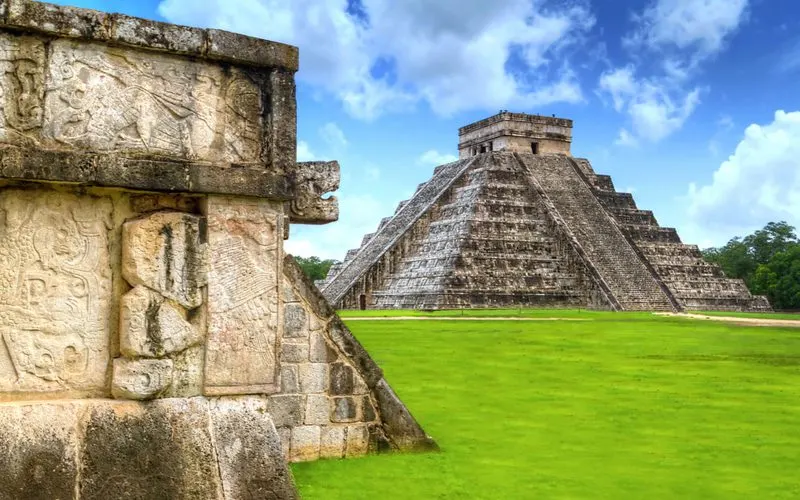
Patryk Kosmider/Shutterstock
Easily the most famous of all the Mayan ruins in Mexico, the ancient town and temple complex of Chichen Itza is breathtaking in its size, architectural details, and 26 still-standing ruins of impressive temples, an observatory complete with a spiral staircase, and tombs.
Chichen Itza tells stories of the Mayan civilization’s architectural styles (even fusing the classic Mayan style with Toltec elements), their daily life, brutal human sacrifice (reliefs in the Great Ballcourt show ritual decapitation), and the city’s rise and sudden fall around 1440 A.D.
The Chichen Itza Pyramid, known as El Castillo or the Temple of Kukulkan, is the structure most people associate with this Mayan town.
Standing 181 feet tall and surrounded by sites like El Caracol observatory, the bone-chilling Skull Wall where sacrifice victims are memorialized in carvings, Jaguar Temple, and Warriors’ Temple, Chichen Itza is a site you can explore for hours.
Tours with boxed lunches, knowledgeable guides, and trips to nearby Valladolid and its own Ek Balam ruins operate daily, or you can pay the entrance fee and explore El Castillo and the surrounding structures at your own pace.
- Location: Yucatan State, Yucatan Peninsula; 2h 45m from Cancun; 4h from Cozumel
- Tours: Daily from 8AM-4:30PM; express and full tours offered
- Cost: $28.50 entry; $74 (children) to $85 (adults) for tours
2. Coba
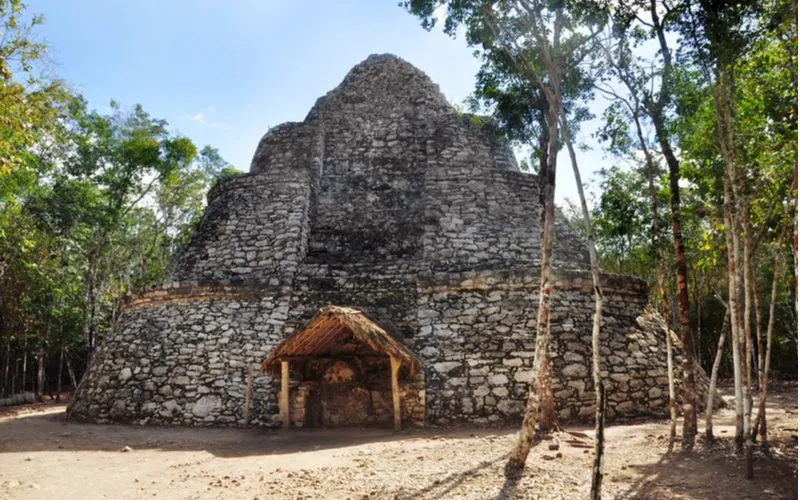
tandemich/Shutterstock
Head deep into the Yucatan jungle to explore one of the most unique Mayan ruins in Mexico in the ancient city of Coba. This mesmerizing site is networked with white stone roads (sacbeob) and was once home to 50,000 people.
You’ll find pyramids, massive stone slabs (stelae) with carved Mayan glyphs, and numerous small settlements to explore. The raised white stone roads connect the different settlements to Nohoch Mul, the highest and central pyramid in Coba, is the centerpiece of the city.
Unlike other Mayan ruins, you can actually climb 120 steps up this pyramid — an unforgettable experience and great photo opportunity!
As you venture through the city, you’ll see the Iglesia (church), two ōllamaliztli courts where the Mayan people played a sport similar to basketball, the Pyramid of Painted Lintel with views of temple paintings, sacrificial altars, and the enormous stelae, or stone slabs covered in glyphs.
Coba wasn’t excavated and explored until the 1920s because it was so densely surrounded by impenetrable jungle. This city in ruins spans about 30 square miles, making it much easier to travel by bicycle or the popular taxi tricycles (“Mayan limousines”) than on foot.
- Location: Quintana Roo, Yucatan Peninsula; 2.5h from Cancun; 3h from Cozumel
- Tours: Open daily from 8AM-4PM; guides, bike rentals, and “Mayan limousine” tours available
- Cost: $4-$5.50 per person; $2.75 parking
3. Tulum
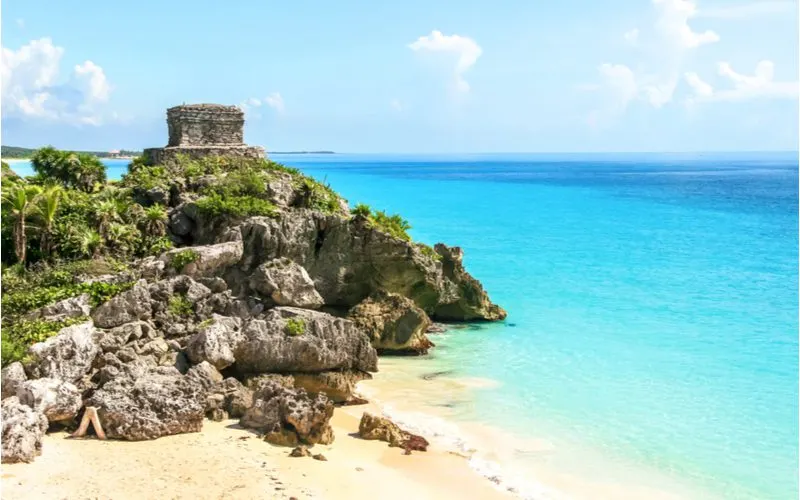
Pola Damonte/Shutterstock
Another site of Mexico’s most well-known Mayan ruins is Tulum, an ancient walled port city of the Maya people located on cliffs overlooking the Caribbean Sea on the Riviera Maya inside of the protected Sian Ka’an Biosphere Reserve.
Tulum’s remarkably-preserved structures include temples, palaces, homes, platforms, murals and reliefs, and a secret cenote. Its seaside location made this city a prosperous center for Mayan trade. The centerpiece is the Castillo, a stunning 25′ tall, 3-level temple on the city’s highest cliff.
A two-room temple sits on top, and a carving of the “Diving God” or “Descending God” can be seen on the front (you’ll find this image repeated throughout the city).
The one-room Temple of the Diving God sits on a high platform and is guarded by a stucco figure of its namesake upside-down deity. It can be accessed by stone steps, while the Temple of Initial Series features a sculpture and stucco relief in the southwestern side of the city.
Painted murals, red handprints, a massive stela stone slab with glyphs, and reliefs featuring the Diving God can be seen in the two-level Temple of the Frescoes.
The Grand Palace is further north and depicts another stucco rendering of the Diving God, while homes and the amazing House of the Cenote (a home built over a natural cenote pool) will be a highlight of your visit.
- Location: Quintana Roo, Yucatan Peninsula; 1h 45m from Cancun; 2h 15m from Cozumel
- Tours: Open daily from 8AM-5PM; private guided tours available
- Cost: $5.30 per person; parking is extra
4. Uxmal
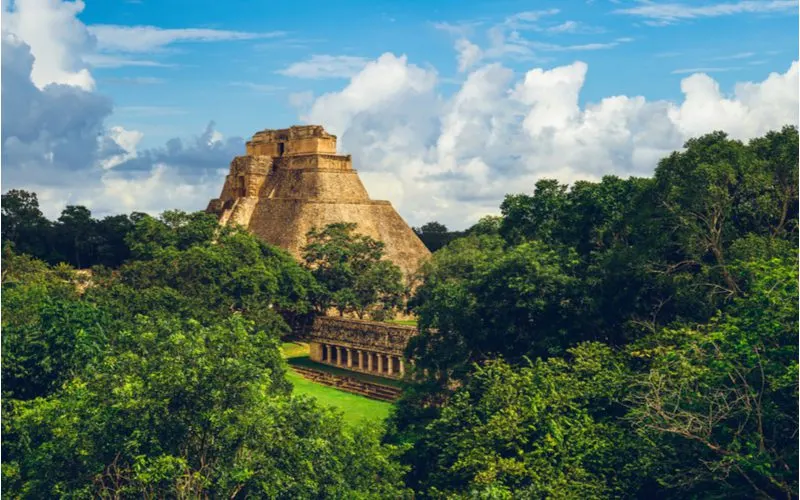
Richie Chan/Shutterstock
Enter the mystical complex of Uxmal, an ancient Mayan city, which contains architectural marvels done in the Puuc style like pyramids, ornately-carved temples, an impressive palace, and a ball court that date back as early as 600 CE (the Classic Maya era).
This sprawling ruined city is best known for the oval-shaped Pyramid of the Magician — said to have been built by the dwarf son of a witch in a single night — and its stately, columned Governor’s Palace featuring high arches, labyrinthian passageways, and a masterful stone mosaic frieze depicting shapes, serpents, and Mayan Chaac masks.
White stone roads (sacbeob) connect the structures of the city that are surrounded by courtyards. You’ll be able to see the oldest temple, Temple I, and Temple II, which is accessed through a hidden hole in the first temple’s staircase.
Temples III and IV can be accessed through the top of the pyramid, while Temple V rests on top of the roof of Temple III. Look for the intricate avian and snake carvings on the House of Birds, then walk though an arch to enter the Nunnery Quadrangle and see its single-level palaces that point North, South, East, and West.
The Stelae Platform shows unique carvings, while the nearby Cemetery Group features skulls and crossbones carvings next to the ancient Mayan Ball Court.
- Location: Yucatan State, Yucatan Peninsula; 4h 40m from Cancun
- Tours: Open daily from 8AM-5PM; guided tours available
- Cost: $32.50 per person; $4-$5 for parking
5. Edzna
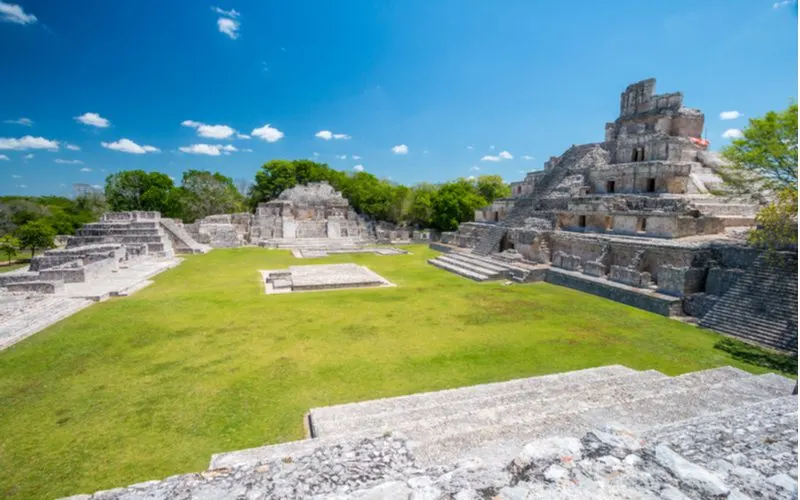
Zoltan.Benyei/Shutterstock
A city once inhabited by the Itzaes people of Mayan descent from 600 B.C. to 1450 A.D., Edzna is a fascinating ruin site to visit in the Campeche state of Mexico.
It was an agriculturally advanced city with its own hydraulic irrigation system and features stunning structures like platforms with hidden chambers, pyramids, temples, and grand staircases carved in stone.
When you enter, you’ll stop by a museum filled with sculptures and stalae, or large stone slabs with carved glyphs of former rulers, and then pass through a jungled path to reach the actual site.
There’s the Platform of Knives with chambers underneath (ancient flint knives were discovered here), and the sprawling Main Plaza ringed by pyramids and temples.
Walk up a stone staircase to the Great Acrópolis, which features well-known sites like the Pyramid of Five Floors with its classic Mayan roof comb, and the Solar Platform, where people observed the skies and tracked astrological events.
The seven-level Temple of the Moon pyramid has chambers at the top, and you can climb it! Don’t miss the views over the city from the top of Nohochná, and check out the Small Acrópolis’ four pyramids (the oldest in the site).
The Temple of the Masks is where you’ll find stucco masks with their original paint still visible, and the ball court gives you a glimpse into daily life and entertainment of this Mesoamerican people.
- Location: Campeche, Yucatan Peninsula; 6h 10m to Cancun; 7h 30m to Cozumel
- Tours: Open daily from 8AM-5PM; guided tours available
- Cost: $5.30 per person; free parking
6. Kohunlich
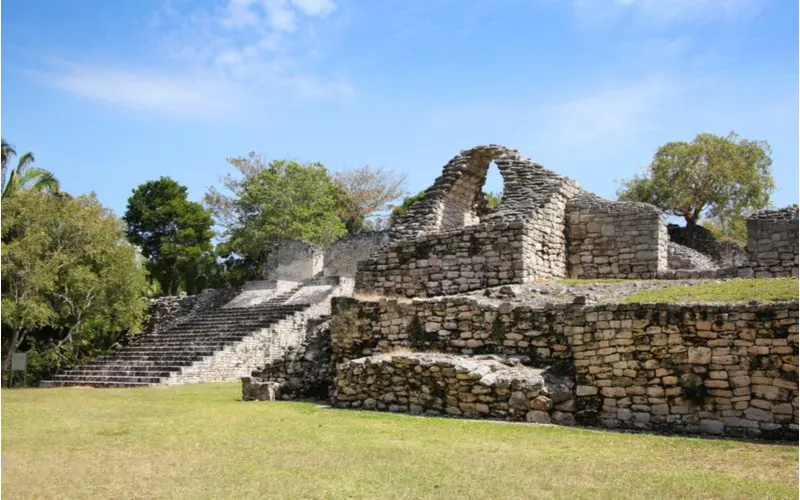
Lisa Strachan/Shutterstock
As one of the more mysterious Mayan ruins in Mexico, Kohunlich hasn’t been as forthcoming with its history. Archaeologists don’t know the original name and didn’t find glyphs or carvings to weave the story of its past rulers and inhabitants.
That makes it that much more alluring to wander the site’s 20 jungled acres along shady paths. There are mossy, crumbling remains of temples, palaces, pyramids, and dwellings throughout the complex along with 200+ burial mounds.
The most striking features of the city are the five stucco Sun God masks (6 feet tall) that adorn the staircase leading up to the Temple of the Masks on the western side of the Main Plaza.
Other plazas surround the Main Plaza and feature structures like the Palace (north side) with a terrace and passageways connecting vaulted chambers, the massive, square Acropolis (west and south side) complex with many chambered structures, sleeping quarters, and original stucco.
The Temple of the King stands tall on the western side with six chambers and terraces at the top, while the nearby Ball Court still stands on the eastern end. You can even see ancient homes with courtyards and patios by taking stairs up to the 27 Steps Group of structures.
- Location: Quintana Roo, Yucatan Peninsula; 6h to Cancun; 6.5h to Cozumel
- Tours: Open daily from 8AM-4:30PM; private guided tours available
- Cost: $4.50 per person; additional fee to bring cameras
7. Yaxchilan
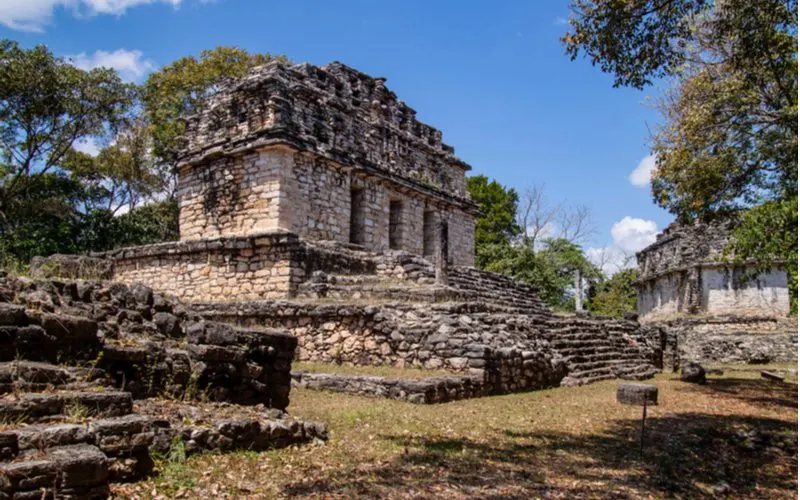
Cody Joseph Painter/Shutterstock
Located on the Southern bank of the Usumacinta River, the ruins of Yaxchilan aren’t the most well-preserved, but they feature some of the best examples of Late Classic Mayan architecture in the temples, narrow entryways, stuccoed roof combs, elaborate staircases, and intricately-carved limestone lintels.
The focal point of the complex is Structure 33, which was built in memory of Bird-Jaguar, an 8th-century ruler of the city. His face is carved into the stucco along the roof comb, while a carved stalactite in front has ties to a cave that was sacred to the people.
It’s where lintels 24 and 25 were found and later taken to the British Museum, some of the most famous Mayan artwork done in high relief.
You’ll come across numerous carved limestone lintels throughout the ancient city depicting rituals and ceremonies that were important to the Maya in Yaxchilan, including scenes of bloodletting by the ruler’s wife, Lady Xook, and the taking of war captives.
Some lintels still feature original paint. There are 80+ structures within the city, grouped at different levels along the riverbank. The Central Acropolis has massive stone slabs, or stelae, with hieroglyphic carvings and nearby altars that were used in rituals and ceremonies.
The Great Plaza, Acropolis West, and South Acropolis are other groups of structures here, some of which are collapsed or still a mystery to archaeologists. Many of the structures here are open to public, but some are in poor condition and closed to visitors at this time.
- Location: Chiapas, Mexico; 15h+ to Cancun; 16.5h to Cozumel
- Tours: Open daily from 8AM-3PM; private guided tours available from Frontera Corozal
- Cost: $5 per person; transportation costs vary widely
What Are the Best Mayan Ruins in Mexico?
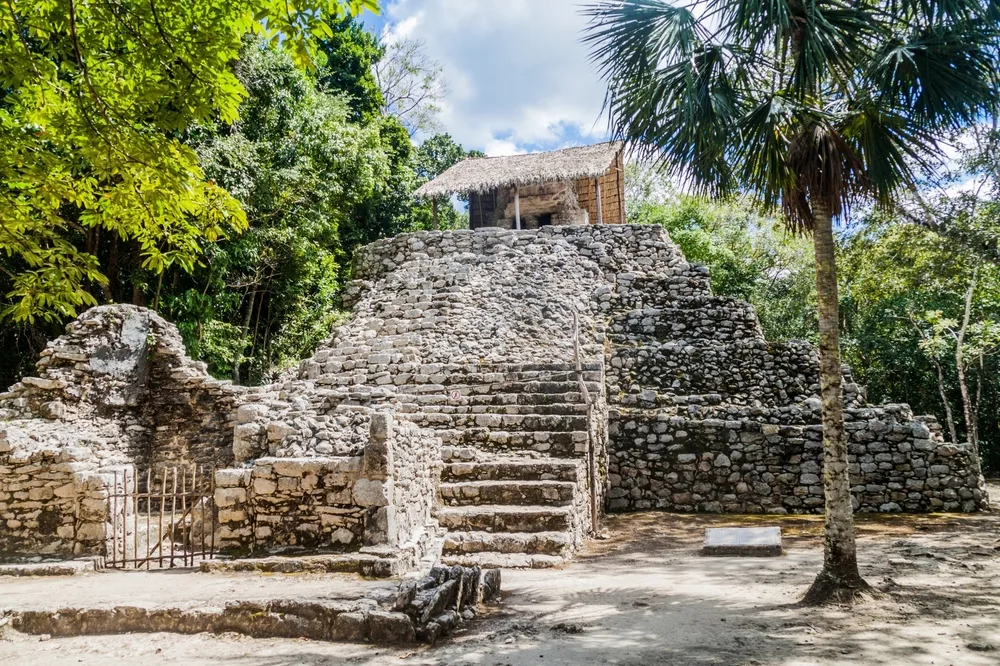
Matyas Rehak/Shutterstock
The best Mayan ruins in Mexico are scattered around the Yucatan Peninsula, spanning areas within the Yucatan, Quintana Roo, Campeche, and Chiapas states.
From the famed Chichen Itza in Yucatan to the stunning Mayan artwork found in Yaxchilan on the border with Guatemala, there are some awe-inspiring ruins to explore while you’re in Mexico.
These ancient cities have crumbled over time, but many structures still stand strong and showcase the incredible craftsmanship, masonry, and architectural design of the Maya people who called Mexico home so long ago.
Today, you can walk right into the world of the past by wandering through the best Mayan ruin sites in the country — just make sure you come prepared to walk!



